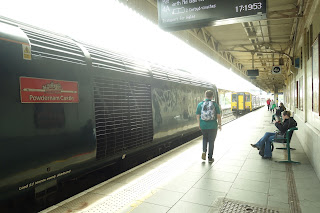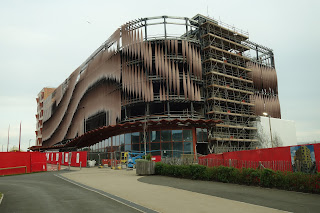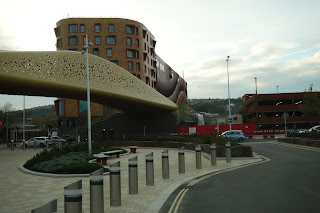The town of Dylan Thomas
A man on the train asked me where I stayed last night. When I answered that it was in Swansea he replied “brave!”.
“The small boy in his invisible engine, the Cwmdonkin Special, its wheels, polished to dazzle, crunching on the small back garden scattered with breadcrumbs for the birds and white with yesterday's snow, its smoke rising thin and pale as breath in the cold afternoon, hooted under the wash-line, kicked the dog's plate at the washhouse stop, and puffed and pistoned slower and slower while the servant girl lowered the pole, unpegged the swinging vests, showed the brown stains under her arms, and called over the wall: 'Edith, Edith, come here, I want you.' “
Dylan Thomas, Patricia Edith and Arnold, in “Portrait of the Artist as a Young Dog”
Swansea is on the GWR mainline from London to Wales which eventually passes nice coastal towns like Tenby to roll out at the docks of Pembroke. In the time of steam this was the destination for trains hauled by the famous castle engines. The train I board in Bristol Temple Meads station takes up this tradition and the engine is called Powderham Castle. Two big Diesel heads are needed to power a short train of four carriages. It is surprising that all the waiting passengers find a seat.
Powderham Castle in Cardiff Central
After Bristol the train passes through the Severn tunnel. The tunnel is one of the master pieces of GWR engineering. The 7 km long tunnel was built between 1873 and 1886 under the guidance of GWR engineer Sir John Hawkshaw. Until 1987 it was the world’s longest underwater tunnel. There is so much seepage of ground water into the tunnel that a culvert has to lead to water into the lowest point from where pumps are constantly operating to get water out of the tunnel. If I would have known that the tunnel fills with water within 25 minutes after the pumps are turned off I probably would have chosen another line.
After we have left the tunnel a conductor wants to see the tickets. This is the first time I see a GWR conductor checking tickets. And the interrail ticket refuses to load on the phone. This happened a couple of times before and could only be resolved by restarting the phone. This is actually the first time that it happens in front of the conductor. Sweat starts to accumulate on my forehead. The friendly conductor is patient and says he will come back later. I finally manage to restart the phone and reload the ticket. To be sure I also safe a screen-shot.
Swansea station
Everybody around me speaks English, a few also Welsh. From here on the train company is transport for Wales (Trafnidiaeth Cymru). The announcements on the platform and trains are in Welsh. This is particularly tricky with place names. Swansea is announced as Abertawe. The train will stop at Pen-y-bont ar Ogwr, Y Pîl, Parcffordd Port Talbot and Castell-Nedd. Obviously I am now at Caerdydd Canolog (Cardiff Central).
Wales is rich in mineral resources. In the south, the South Wales coal field in combination with limestone deposits led to the development of heavy industry. The steel works were centered in particular around Swansea, Cardiff, Barry, Newport and Llanelli. The ports could also be used to ship out coal. In particular in Swansea Copper was brought in from Cornwall. Swansea became nicknamed Copperopolis, the Copper capital of the world. Moreover, arsenic, zinc, tin, gold and silver were produced.
“She did not try to stop him when he climbed up the coal-heap. He stood quietly on the top, King of the Coal Castle, his head touching the roof, and listened to the worried voices of the girls. Patricia was almost in tears, Edith was sobbing and rocking on the unsteady tubs. 'I'm standing on the top of the coal,' he said, and waited for Patricia's anger.”
Dylan Thomas, Patricia Edith and Arnold, in “Portrait of the Artist as a Young Dog”
In the 20th century the heavy industry in Swansea steadily declined. West of Swansea a deep sea harbor was built in Port Talbot and in 1947 the new Abbey steelworks were built. Competent management led to a series of steps of nationalization and privatization. Ironically enough the works are now owned by the formerly colonized, Indian owned Tata steel. Abbey works in Port Talbot is one of the two remaining active steel works in the UK. The name comes from Margam, a Cistercian monastery. Its remains are preserved on the grounds, it is said.
The city was dealt a further blow with the Swansea Blitz. Between 19th and 21th February 1941 the city was extensively bombed.
Swansea station
The Dragon hotel
After industry disappeared the city is trying to find a new purpose. There is potential. The setting is beautiful along the coast with attractive mountains as backdrop. Gower peninsula area of natural beauty is just a short way off. The old industrial areas are reclaimed. The docks are converted into recreational use and the city tries to promote its beach. One of the few old buildings, the Guildhall built in 1825, was converted into a Dylan Thomas center. Outside the center, on the shadow side, stands a bronze statue of Thomas. The car park occupies the sunny side.
Dylan Thomas Center in the old Guilthall in Swansea
Dylan Marlais Thomas (1914 – 1953) was a Welsh poet and writer. His autobiographical stories in “Portrait of the Artist as a Young Dog” are set in his birthplace Swansea.
“He was the senior reporter, a great shorthand writer, a chain-smoker, a bitter drinker, very humorous, round-faced and round-bellied, with dart holes in his nose. Once, I thought as I stared at him then in the lavatory of the offices of the Tawe News, he might have been a mincing-mannered man, with a strut and a cane to balance it, a watch-chain across the waistcoat, a gold tooth, even, perhaps a flower from his own garden in his buttonhole. But now each attempt at a precise gesture was caked and soaked before it began; when he placed the tips of his thumb and forefinger together, you saw only the cracked nails in mourning and the Woodbine stains. He gave me a cigarette and shook his coat to hear matches”
Dylan Thomas, Old Garbo, in “Portrait of the Artist as a Young Dog”.
Swansea should try to promote itself as a destination for architects and city planners. There are few places in the world where all the mistakes these professions can make can be studied in one location.
The new parking structure built for the concert hall
Most of the development here pointed at the layout of new thoroughfares, parking lots and shopping centers. I think they occasionally expect a lot of visitors because most of the parking lots are empty. The most iconic new building of the recent years is the new parking garage which is connected to the new concert hall by a bridge above the main road. The road cuts the city in halves. Automobile accessibility and ease of parking seems to be the main motivation for city planning.
Most of the new buildings are faceless modern structures which could be anywhere. Where is the tradition of those great architects and engineers this country brought forward before? The redevelopment of the town lacks any architectural harmony. Brutal new buildings disregard anything old or traditional. Swansea castle built in 1106 is locked up between a busy thoroughfare and highrises casting their shadows on the old structure.
Cardiff castle
In the old shopping streets traditional buildings are freely blended with cheap modern cardboard boxes built for easy demolition. To adapt the old buildings to the ugliness of the neighbor the ground floor shop fronts were generally torn out and replaced by a modern glass facade. If bigger flat surfaces are available they can be covered with larger commercials of the enterprises selling their crap inside.
Shopping area in Cardiff
“We stood in the scooped, windy room of the arch, listening to the noises from the muffled town, a goods train shunting, a siren in the docks, the hoarse trams in the streets far behind, one bark of a dog, unplaceable sounds, iron being beaten, the distant creaking of wood, doors slamming where there were no houses, an engine coughing like a sheep on a hill.”
Dylan Thomas, Just like little dogs, in “Portrait of the Artist as a Young Dog”
The sounds of Dylan Tomas’ times are gone with the port activities, the industry and the railway.
I wonder how people in such a raped town find some joy and pleasure. There is a university but there are few pedestrians in the streets. Most cars in the street seem to have a muffler problem. The stench of burnt tires and exhaust fumes hangs in the streets. The drivers seem to dispose of anything unnecessary by throwing it into the streets. Of course there is the one pedestrianized skid row full of pubs. That is where the part of the male population hangs out who do not spend their time in a roaring car.
The entertainment street in Swansea
There is lots of police around in the center of town, some on horses. There are demonstrations for work and money, but they do not draw a lot of participants. Probably they are guarding the drunkards.
I do not find a single inviting restaurant. Finally I go to the brasserie, the restaurant of the Dragon hotel. It is next to empty, probably because they have turned their television to a level suitable for the entirely deaf. The two other customers are locals covered in tattoos who seem to finish their beer in about the time the barman can draft the next one. Conversation is in loud roars, but that might be caused by the television. I ask for local Ale and have to convince the barman that Coors is not a local beer. Ordering vegetarian curry is probably the least risky here. I ask the guy whether it is very hot. He replies that it does not have to be. After a couple of minutes he comes back and asks whether I want to have my curry cold. I try to explain the difference between hot and spicy. Eventually the curry arrives with fries on the side….
“He thought: Poets live and walk with their poems; a man with visions needs no other company”, Dylan Thomas, One warm Saturday, in “Portrait of the Artist as a Young Dog”
Dylan Thomas wrote in English. Although he had a deep connection with Wales he disliked being regarded as a provincial poet, he disliked Welsh nationalism and decried any notion of 'Welshness' in his poetry.
There are different varieties of license plates here. There still is the pre-Brexit GB plate with an EU flag in the blue field. But there also is the Cymru plate. Very few in combination with a GB or EU flag.
Thomas had difficulties to earn his living as a writer. He increased his income with reading tours and radio broadcasts. In the 1950s he started to travel to the United States. Maybe his performances became famous because of his erratic behavior and drinking. He deliberately shocked people. On his third tour he fell down a flight of stairs when drunk and broke his arm.
During his fourth trip to New York in 1953 air pollution in New Yorkwas so bad that 200 people had died from smog. Thomas had a chest illness. This did not prevent him from going out on 3 November to have drinks. , Thomas spent most of the day in his room, entertaining various friends.[229] He went out in the evening to keep two drink appointments. After returning to the hotel, When returning to the Hotel Chelsea, he declared, "I've had eighteen straight whiskies. I think that's the record!". The next day he felt ill and was admitted to St Vincent's Hospital in a state of coma.
His wife Caitlin arrived the following day. Her reported first words were, "Is the bloody man dead yet?" She was so drunk that she became uncontrollable, put in a straitjacket and admitted to the River Crest private psychiatric detox clinic on Long Island.
Probably Thomas had a combination of bronchitis, pneumonia, emphysema and asthma before his admission to St Vincent's Hospital. He died on 9 November 1953 and his body was returned to Wales.
“In the morning I woke from a dream of fiery horses on a plain that was littered with furniture, and of large, cloudy men who rode six horses at a time and whipped them with burning bed-clothes.“
Dylan Thomas, A visit to Grandpa’s, in “Portrait of the Artist as a Young Dog”
The sollicitor's house. As always fit for Saul Goodman



































No comments:
Post a Comment